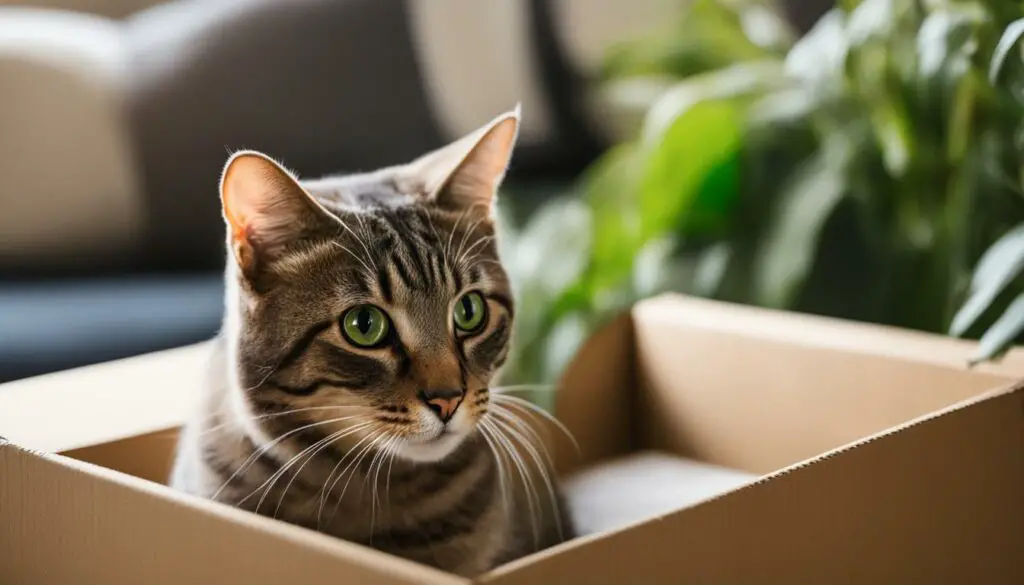Deciding whether to get a cat is a big decision. Cats can bring joy, companionship, and a lot of love into your life. However, responsible pet ownership requires careful consideration and preparation. Before bringing a cat into your home, it’s important to understand the basics of cat ownership and what it entails. In this article, we’ll explore the importance of training your cat, different training methods, and essential tips for successful training. We’ll also discuss the specific care needs of kittens, adult cats, and senior cats. By the end of this article, you’ll have a better understanding of what it takes to be a cat owner and how to provide the best care for your furry friend.
Key Takeaways
- Training your cat is essential for their health, well-being, and the harmony of your home.
- Positive reinforcement-based training methods, such as clicker training, are effective for teaching cats desired behaviors.
- Understanding your cat’s body language and training them when they are hungry but not too full can enhance the success of training sessions.
- When introducing a new kitten to your home, gradual introductions and supervised interactions with existing cats are recommended.
- Proper care for senior cats includes monitoring their health, providing appropriate nutrition, and addressing urinary tract infections promptly.
The Importance of Training Your Cat
Training your cat is not just about teaching them tricks; it plays a crucial role in their overall well-being. Cats have an instinctual need to hunt, catch, and kill, and training provides the mental stimulation that satisfies this need. By engaging in training sessions, cats can channel their energy and prevent boredom, destructive behavior, and obesity.
Cats are motivated by positive attention, playtime, and food. Positive reinforcement-based training is the simplest and most effective method for training cats. It involves rewarding your cat when they do something you like. Clicker training and auditory markers can also be used to mark desired behaviors. These methods can be used to train cats to sit, lie down, recognize their names, and perform other desired behaviors.
Training your cat not only stimulates their mind but also improves their behavior. It allows you to establish boundaries and communicate effectively with your feline companion. Through training, you can teach your cat to respond to commands, reduce inappropriate behaviors, and strengthen your bond with them.
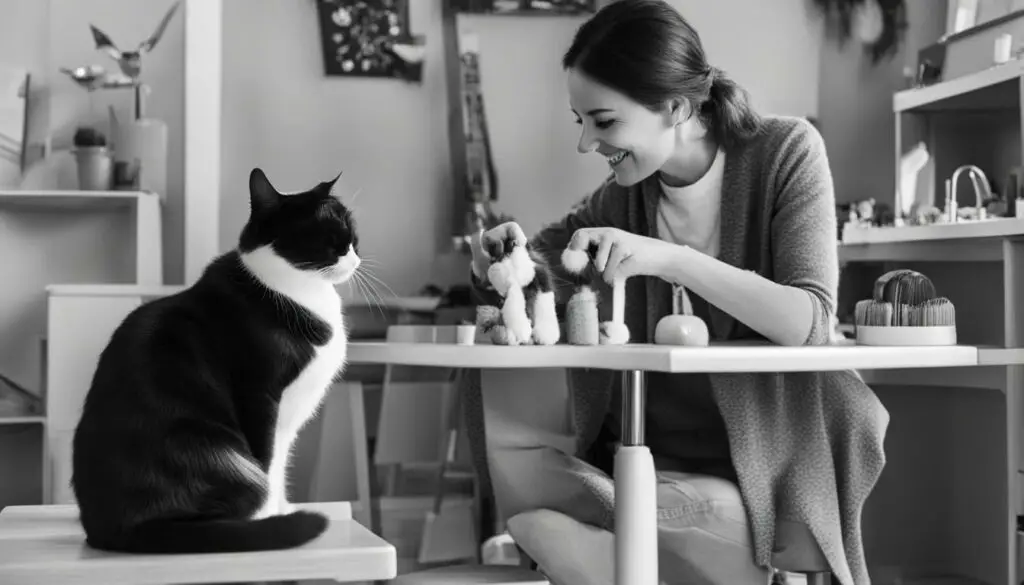
The Benefits of Training Your Cat
Training your cat offers numerous benefits, including:
- Mental stimulation: Training provides your cat with mental challenges and helps prevent boredom.
- Behavioral management: Training can help address and prevent undesirable behaviors such as scratching furniture or aggression.
- Bonding and communication: Training strengthens the bond between you and your cat and enhances your ability to communicate effectively.
- Physical exercise: Training sessions can incorporate physical activities, allowing your cat to stay active and healthy.
By prioritizing training, you are providing your cat with a fulfilling and enriched environment that contributes to their overall happiness and well-being.
Training Methods for Cats
Training your cat is an essential part of responsible pet ownership. Positive reinforcement-based training methods have proven to be effective in teaching cats various behaviors and commands. By using rewards and incentives, such as treats, you can motivate your cat to learn and perform desired actions.
One popular training method is clicker training. This involves using a clicker to mark the desired behavior and then rewarding your cat with a treat. The clicker serves as a consistent sound cue that lets your cat know they have done something right. Over time, they will associate the click with the reward and be more likely to repeat the behavior.
Another training technique is auditory markers. Instead of using a clicker, you can use verbal cues, such as saying “good” or “yes” when your cat performs the desired behavior. Again, this is followed by a reward to reinforce the behavior. Auditory markers can be particularly useful when training cats who may be sensitive to loud noises.
Training Methods for Cats
| Training Method | Description |
|---|---|
| Positive Reinforcement | Rewarding your cat when they perform desired behaviors |
| Clicker Training | Using a clicker to mark the behavior and associate it with a reward |
| Auditory Markers | Using verbal cues to mark the behavior and reward your cat |
Consistency and patience are key when training your cat. It’s important to set clear expectations, be consistent with your training sessions, and have realistic goals. Remember to keep training sessions short and enjoyable for both you and your cat. With time and practice, your cat will become more responsive to training and develop new skills.
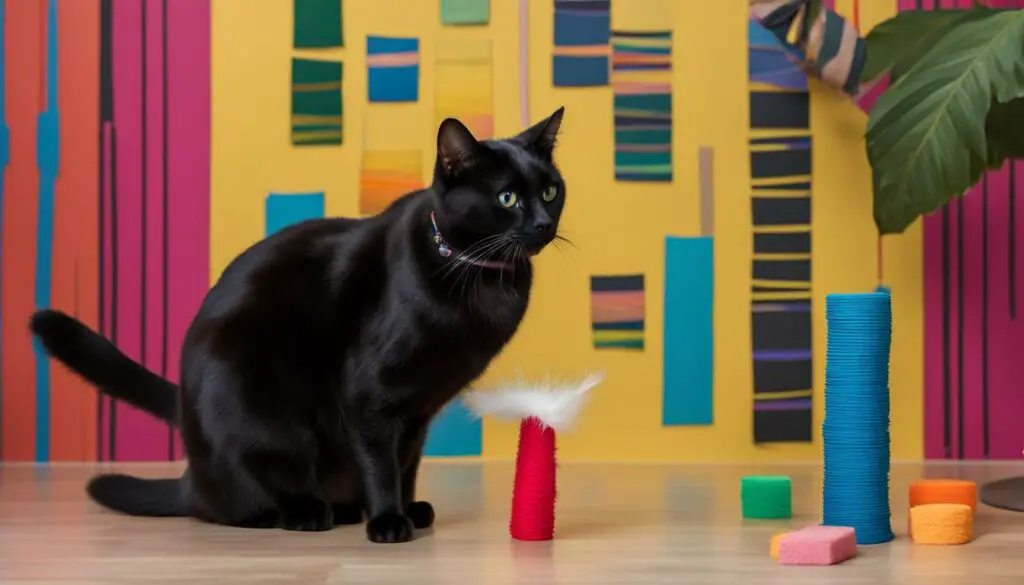
Tips for Training Your Cat
When it comes to training your cat, understanding their body language is essential. Cats use a variety of signals to communicate their mood and comfort level. For example, a relaxed and happy cat may have a loose posture with their tail up, while an anxious or frightened cat may crouch down with their ears flat. By observing and interpreting these cues, you can ensure that training sessions are positive and stress-free for your cat.
During training, it’s important to use rewards that motivate your cat. While treats are commonly used as a training reward, some cats may prefer playtime or verbal praise. Experiment with different rewards to find what your cat responds to best. Remember to reward your cat immediately after they perform a desired behavior to reinforce the association between the behavior and the reward.
When training your cat, it’s best to start with one behavior at a time. Trying to teach too many things at once can be overwhelming for both you and your cat. Focus on one command, such as “sit” or “come,” and consistently work on it until your cat has mastered it. Short, frequent training sessions of a few minutes each are more effective than long, exhausting sessions.
Common Cat Body Language Signals
- Ears forward: Indicates interest or excitement
- Ears flattened to the side: Indicates fear or aggression
- Tail up and relaxed: Indicates a happy and confident cat
- Tail low and tucked: Indicates fear or submission
- Purring: Indicates contentment and relaxation
Remember, training should be a partnership between you and your cat. By understanding their body language and using rewards that they find motivating, you can create a positive training experience that strengthens your bond and enhances their well-being.
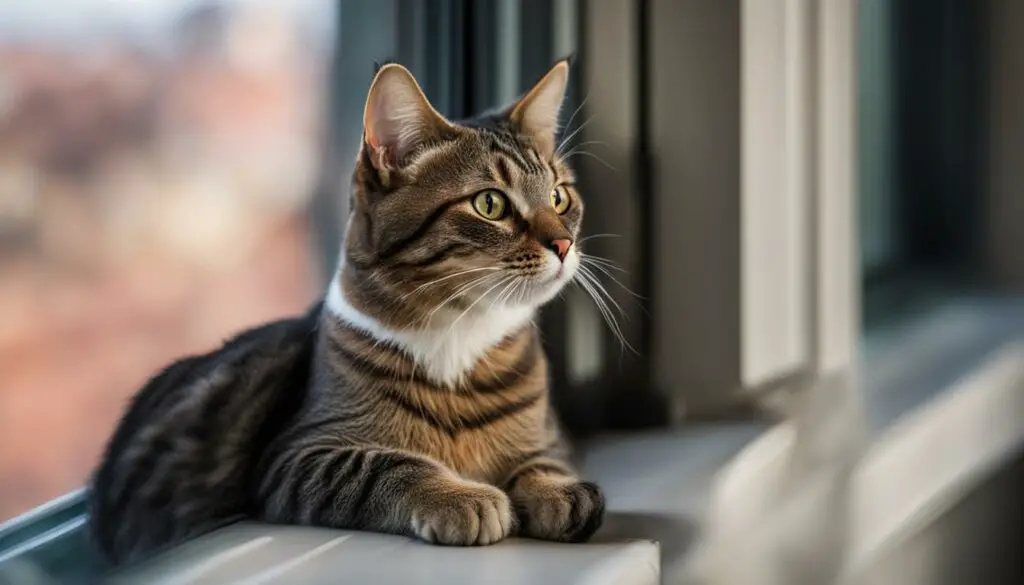
Table: Training Rewards for Cats
| Reward | Description |
|---|---|
| Treats | Small, bite-sized treats that your cat finds delicious |
| Playtime | Engaging toys and interactive play sessions |
| Verbal praise | Positive, encouraging words spoken in a cheerful tone |
| Clicker | A device that makes a distinct sound to mark desired behaviors |
What You Need to Train Your Cat
When it comes to training your cat, having the right tools and treats can make all the difference. Let’s take a look at the essential items you’ll need to successfully train your feline friend.
1. Cat Training Tools
One of the key tools for cat training is a clicker. This small handheld device emits a distinct clicking sound when pressed. It’s used to mark the desired behavior and signal to your cat that they’ve done something right. Clickers are effective in shaping your cat’s behavior and can be easily found in pet stores or online.
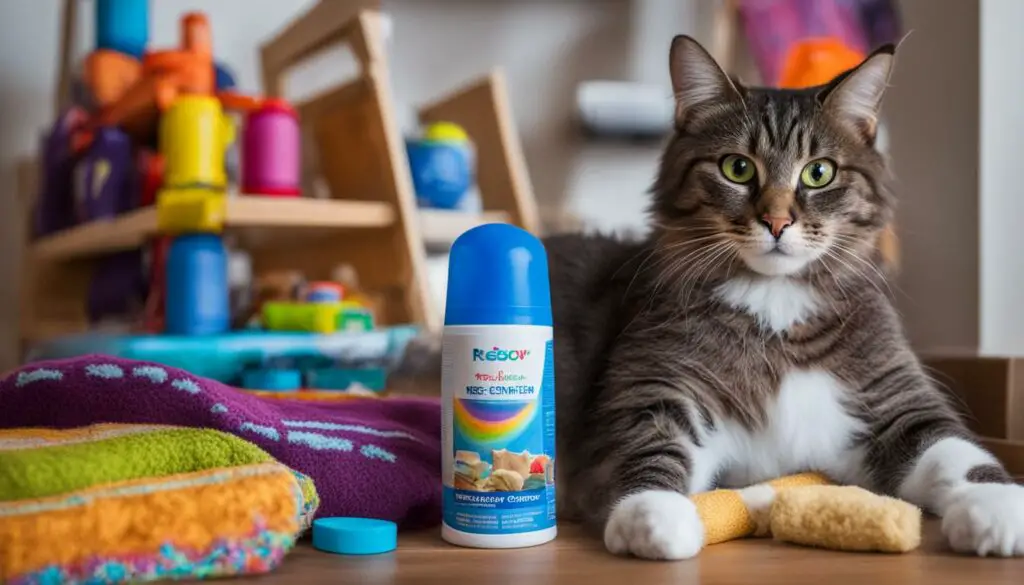
2. Irresistible Cat Treats
Treats are an essential part of cat training as they serve as positive reinforcement. Find treats that are irresistible to your cat and use them to reward good behavior. Whether it’s small pieces of chicken, tuna, or specially formulated cat treats, choose something that your cat absolutely loves. Reserve these treats exclusively for training sessions to make them more enticing and rewarding for your cat.
| Treats | Description |
|---|---|
| Chicken | Small pieces of cooked chicken are a favorite for many cats. |
| Tuna | Chunks of tuna packed in water can be a tasty reward for your feline friend. |
| Cat Treats | There are a variety of cat treats available in pet stores, from crunchy to soft options. |
With these essential tools and treats, you’ll be well-equipped to start training your cat. Remember, patience and consistency are key when it comes to training your furry friend. Be sure to make the training sessions fun and positive for both you and your cat, and watch as your feline companion learns new behaviors and tricks.
Training Your Cat to Follow Commands
Training your cat to follow commands can be a fun and rewarding experience for both of you. With a little patience and the right techniques, you can teach your furry friend to sit, lie down, and even recognize their name. Here are some simple steps to get started:
- Training a cat to sit: Start by holding a treat above your cat’s head and slowly move it towards their tail. As they naturally look up at the treat, their bottom will naturally lower into a sitting position. Once they are sitting, give them the treat and praise them with a gentle pat or a reassuring word.
- Training a cat to lie down: Begin by asking your cat to sit. Once they are in a sitting position, hold a treat close to the ground, near their front paws. As they lower their body to reach for the treat, say the cue word “lie down” and give them the treat when they are fully stretched out on the ground. Repeat this process a few times until they start to associate the cue word with the action.
- Training a cat to recognize its name: Use your cat’s name in a positive and cheerful tone whenever you interact with them. Start by saying their name right before you feed them or give them a treat. Over time, they will begin to associate their name with positive experiences. To reinforce this connection, reward them with a treat or praise when they turn to look at you after you say their name.
Remember, training a cat requires patience and consistency. Keep training sessions short and always end on a positive note. Celebrate small successes along the way and never punish or force your cat to perform a behavior. With time and practice, your cat will become a pro at following commands.
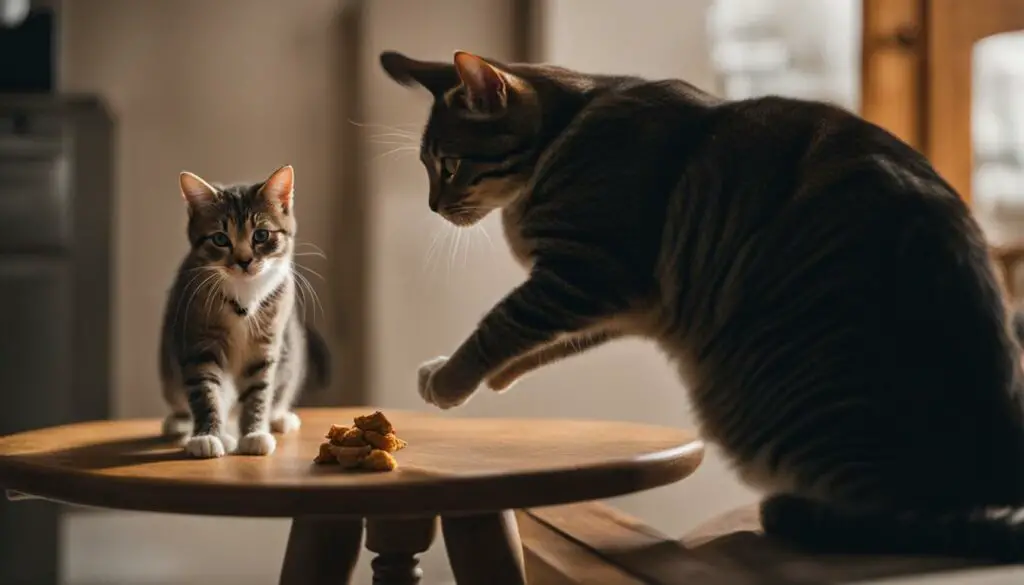
Quote:
“Training a cat is all about understanding their natural instincts and creating positive associations. By using rewards and repetition, you can help your cat learn new commands and behaviors while strengthening the bond between you.”
Kitten Care: Giving Your Feline Friend the Best Start in Life
Bringing a kitten into your home is an exciting and rewarding experience. As a responsible pet owner, it’s important to provide the best care for your furry friend during their early stages of life. Kitten care encompasses a range of essential aspects such as litter box training and proper nutrition. By understanding their unique needs, you can ensure a healthy and happy start for your adorable new companion.
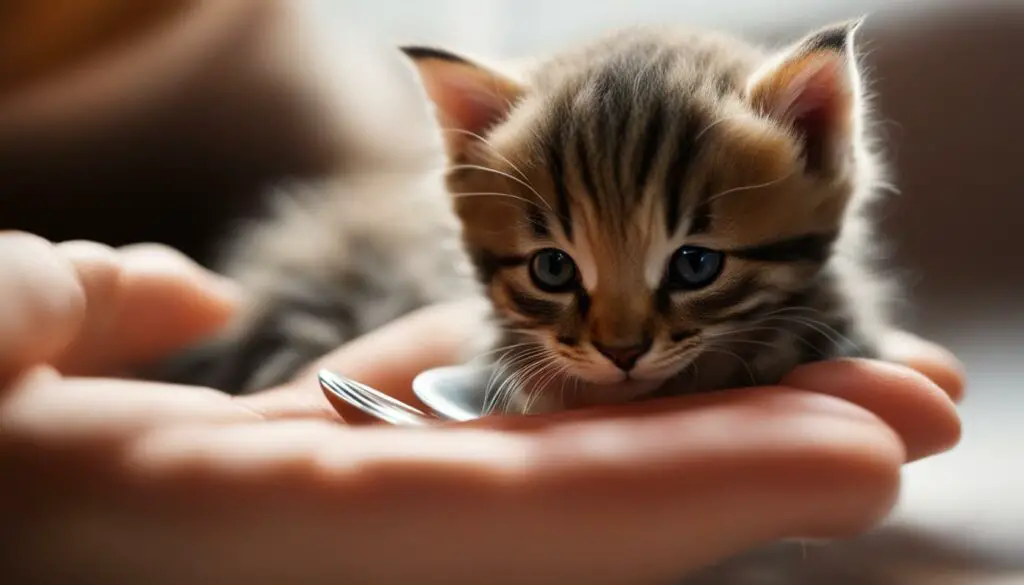
Key Takeaways:
- Proper litter box training is crucial for kittens to establish good habits from the start.
- Choosing a suitable litter and introducing it gradually can ease the transition for your kitten.
- Provide a balanced and nutritionally complete diet specifically formulated for kittens.
- Consult with a veterinarian to ensure your kitten receives all the necessary vaccinations and preventive care.
- Regular playtime and socialization are important for your kitten’s mental and physical development.
Introducing a New Kitten to Your Home
Bringing a new kitten into a multi-cat household requires careful introduction and gradual adjustment for a harmonious coexistence. Cats are territorial animals, and sudden changes can lead to stress and conflict. By following these steps, you can help your new kitten and existing cats form positive relationships:
Create a Safe Space
Start by setting up a separate room for the new kitten, equipped with food, water, a litter box, and toys. This allows the kitten to acclimate to their scent and surroundings before interacting with the other cats. Make sure the room is secure, with no small spaces the kitten can escape through.
Exchange Scents
To help familiarize your cats with each other’s scent, rub a towel or cloth on the new kitten and place it near the other cats’ belongings. Do the same with the existing cats and introduce their scents to the kitten’s space. This gradual scent exchange can help reduce tension and create familiarity.
Supervised Interactions
Begin introducing the cats under controlled and supervised conditions. Start with short, controlled interactions during mealtime, where the cats can see each other but still maintain physical boundaries. Gradually increase the duration of these interactions while observing their behavior and body language.
Remember to reward positive interactions and provide individual attention and playtime for each cat. This helps them associate each other’s presence with positive experiences and reinforces good behavior. It’s important to be patient and allow the cats to set their own pace for acceptance and bonding.
Introducing a new kitten to your home can be a rewarding experience for both the kitten and your existing cats. With proper introduction and gradual adjustment, you can help foster positive relationships and create a harmonious multi-cat household.
| Benefits of Gradual Introductions | Benefits of Supervised Interactions |
|---|---|
| – Reduces stress and tension for all cats involved | – Allows observation and monitoring of body language |
| – Gives cats time to acclimate to each other’s scents | – Rewards and reinforces positive behavior |
| – Helps establish territory and hierarchy | – Prevents aggressive or fearful behavior |
Adult Cat Care: Behavior and Health
As your cat enters adulthood, it’s important to provide them with the proper care to ensure their behavior and health remain in top shape. Adult cats may face certain challenges, such as inappropriate elimination and territorial issues in multi-cat households. Additionally, grooming becomes essential for maintaining a healthy coat and preventing hairballs.
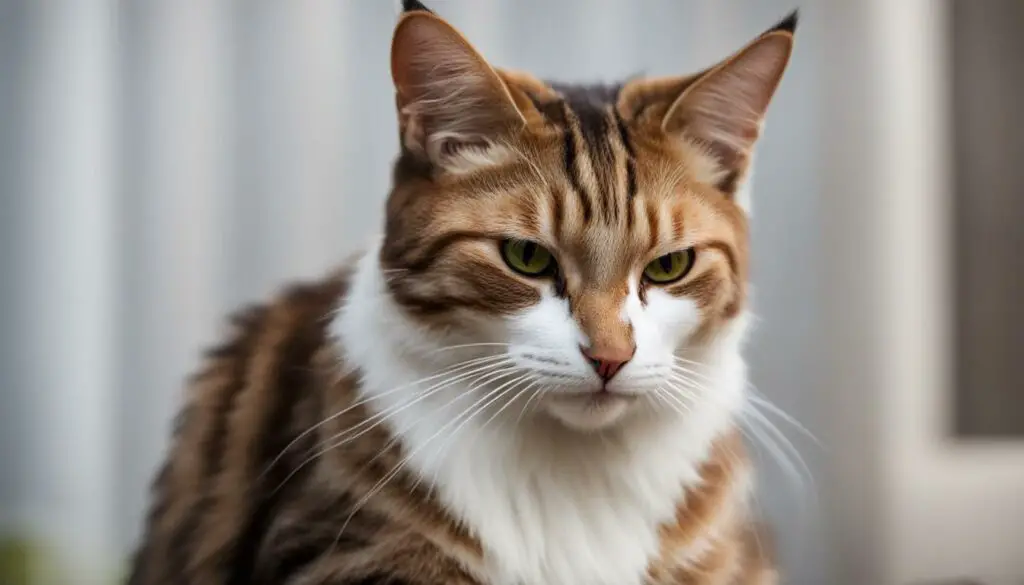
Key Takeaways:
- Understanding cat behavior is crucial for addressing and preventing issues like inappropriate elimination and territorial conflicts in multi-cat households.
- Regular grooming helps keep your cat’s coat healthy, reduces hairballs, and strengthens the bond between you and your feline friend.
- Providing dedicated litter boxes for each cat in a multi-cat household can help prevent territory-related problems.
- Consult with a veterinarian promptly if you notice any changes in your cat’s litter box behavior or suspect urinary tract infections in senior cats.
- Ensure your adult cat receives a balanced diet and monitor their weight to prevent health issues.
The Challenges of Inappropriate Elimination in Cats
Inappropriate elimination, also known as litter box problems, is a common issue faced by cat owners. It can be frustrating and stressful, but it’s essential to address this behavior promptly and effectively. In this section, I will discuss the causes of inappropriate elimination, litter box training techniques, and tips to help prevent and manage this problem.
Causes of Inappropriate Elimination
There are several reasons why cats may start eliminating outside of their litter box. It could be due to medical issues such as urinary tract infections, kidney problems, or gastrointestinal disorders. Stress, anxiety, and changes in the household environment can also trigger this behavior. It’s crucial to rule out any underlying health problems and address them accordingly before focusing on behavioral interventions.
Litter Box Training Techniques
Litter box training is essential for cats of all ages. Start by providing a clean and accessible litter box in a quiet and private area of your home. Use a litter that your cat prefers and scoop it regularly to maintain cleanliness. If your cat has been eliminating outside the litter box, gradually move the box closer to the preferred elimination area until it is in the desired location. Additionally, consider adding multiple litter boxes in different areas of your home, especially in multi-cat households.
Tips to Prevent and Manage Inappropriate Elimination
- Keep the litter boxes clean and odor-free to encourage your cat to use them.
- Provide enough litter boxes based on the number of cats in your household.
- Address any potential stressors in your cat’s environment, such as introducing new pets or changes in routine.
- Use pheromone sprays or diffusers to create a calming environment for your cat.
- Consult with a veterinarian or a professional animal behaviorist if the problem persists, as they can provide guidance and recommend specific strategies for your cat’s situation.
By understanding the causes of inappropriate elimination and implementing appropriate litter box training techniques and preventive measures, you can effectively address this issue and create a clean and comfortable environment for your cat.
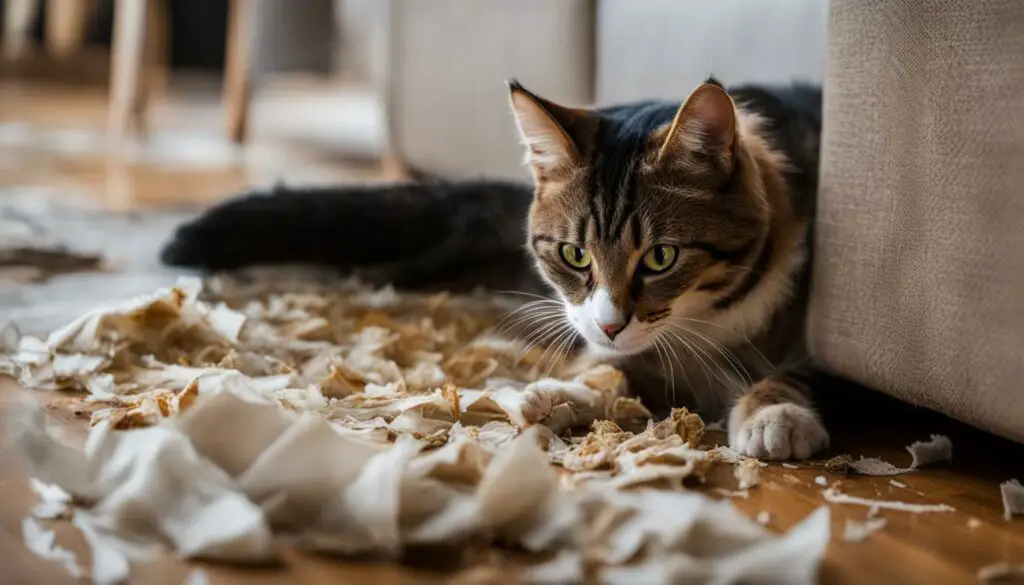
Grooming Your Adult Cat
Grooming plays a crucial role in keeping your adult cat’s coat healthy and preventing hairballs. Regular grooming sessions not only help maintain a clean and shiny coat but also provide an opportunity for bonding with your feline friend. Here are some essential cat grooming tips to keep in mind:
- Start grooming sessions early to get your cat accustomed to the process. Use gentle strokes and positive reinforcement to make it a positive experience.
- Brush your cat regularly to remove loose hair and prevent matting. Choose a brush suitable for your cat’s coat type, such as a slicker brush for long-haired breeds or a rubber curry brush for short-haired cats.
- Pay extra attention to sensitive areas such as the belly, armpits, and hindquarters. These areas are prone to matting and may require more frequent brushing.
- Trim your cat’s nails regularly to prevent them from becoming too long and causing discomfort or injury. Use cat-specific nail clippers and be cautious not to cut into the quick, the sensitive part of the nail.
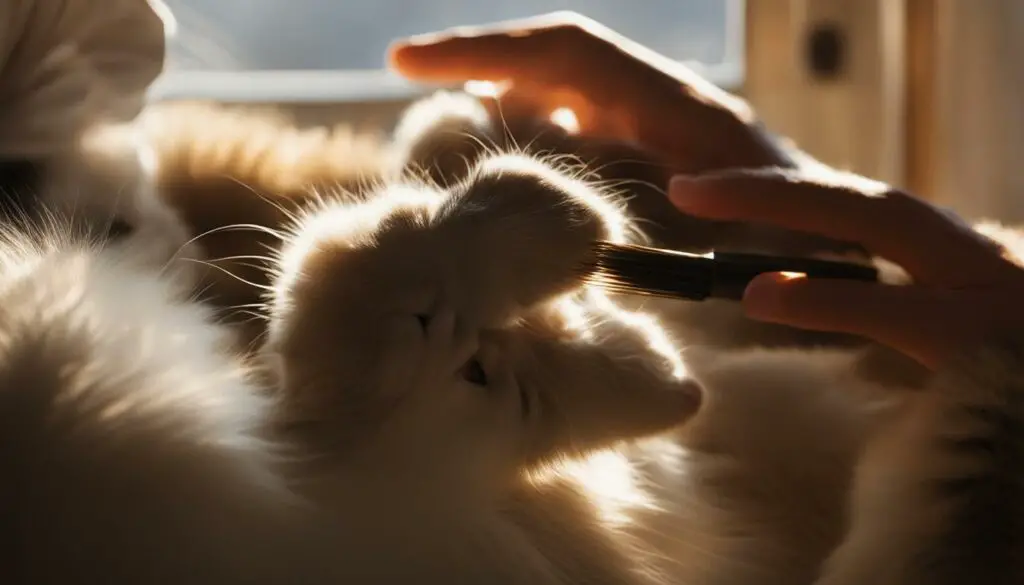
It’s important to note that not all cats enjoy being groomed, and their tolerance may vary. If your cat becomes stressed or agitated during grooming, take breaks, and try again later. Alternatively, you can seek professional grooming services to ensure your cat’s needs are met.
Regular grooming and maintenance of your cat’s coat can go a long way in preventing hairballs, which can be a common issue in cats. By keeping your cat’s fur free from tangles and excessive shedding, you can minimize the amount of hair your cat ingests during self-grooming, reducing the likelihood of hairball formation.
Remember, grooming is more than just a cosmetic routine. It promotes a healthy coat, prevents hairballs, and allows you to monitor your cat’s overall well-being by checking for any skin abnormalities, parasites, or lumps. It’s a vital aspect of responsible cat ownership that contributes to your cat’s comfort, health, and happiness.
The Challenges of Managing a Multi-Cat Household
As a cat owner, I have always been drawn to the charm and companionship that comes with owning multiple cats. However, managing a multi-cat household does come with its fair share of challenges. From understanding cat social behavior to preventing territorial issues, it takes careful planning and attention to ensure a harmonious environment for all feline residents.
One of the main challenges in a multi-cat household is preventing territorial issues. Cats are naturally territorial, and when they share living space, conflicts can arise. To address this, it is important to provide each cat with their own designated territory and resources. This includes separate feeding areas, litter boxes, and resting spots. By providing each cat with their own space, you can reduce the likelihood of territorial disputes and promote a more peaceful coexistence.
Another crucial aspect of managing a multi-cat household is understanding cat social behavior. Cats have complex social dynamics and hierarchies within their groups. It is important to observe their interactions and intervene when necessary to prevent bullying or aggression. Additionally, providing ample opportunities for play and enrichment can help alleviate any potential stress or boredom, enhancing social bonds between cats and reducing the likelihood of behavioral issues.
To summarize, owning multiple cats requires a thoughtful approach to prevent territorial issues and promote harmonious living. Understanding cat social behavior and providing individual territories and resources is key to maintaining a peaceful coexistence. By taking these steps and promoting a positive and enriched environment, you can create a loving and happy multi-cat household for all your feline companions.
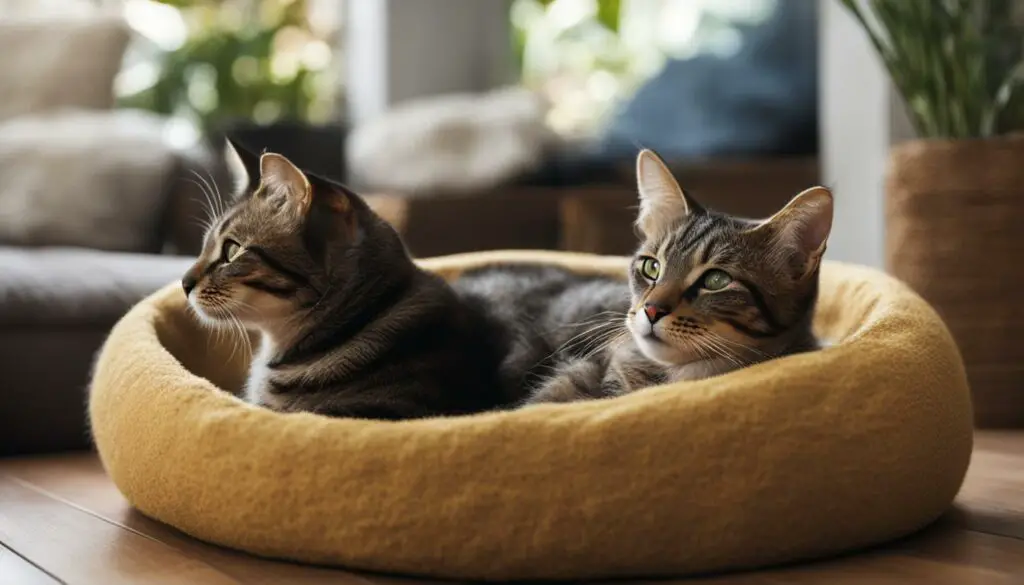
Maintaining a Harmonious Multi-Cat Household: Tips and Tricks
Here are some practical tips to help you manage a multi-cat household:
- Provide multiple litter boxes: Aim for one litter box per cat, plus an extra one. This ensures that each cat has access to their own designated bathroom area and helps reduce territorial issues.
- Offer vertical space: Cats love to climb and perch. Install cat trees, shelves, or window perches to give each cat their own elevated space, reducing competition for territory on the ground.
- Establish a feeding routine: Feed each cat in separate areas at scheduled times to prevent food competition and potential aggression. This also allows you to monitor each cat’s appetite and health.
- Foster positive interactions: Encourage playtime and interactive toys to promote positive social interactions between your cats. This helps strengthen their bond and prevent boredom-related behavioral issues.
- Monitor and address conflicts: Keep an eye out for any signs of aggression or tension between your cats. If conflicts arise, intervene calmly by redirecting their attention or providing distractions.
By implementing these strategies and understanding the complexities of cat social behavior, you can create a harmonious multi-cat household where all your furry friends can thrive.
Senior Cat Care: Aging Gracefully
I understand the importance of providing specialized care for senior cats to ensure their health and well-being. As cats age, they become more vulnerable to certain health issues, such as urinary tract infections and kidney failure. It is crucial to monitor their health closely and make necessary adjustments to their nutrition and lifestyle.
Proper nutrition plays a vital role in maintaining the overall health of senior cats. They require a diet that supports their muscle and bone health while addressing their changing energy requirements. Additionally, regular veterinary check-ups are essential for early detection of any potential health concerns.
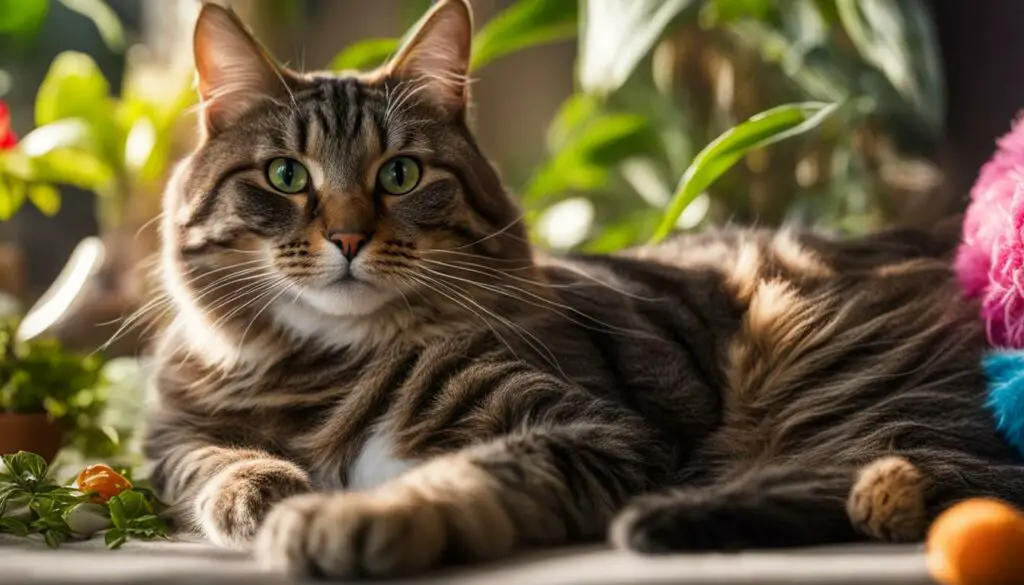
Key Takeaways:
- Senior cats are more prone to urinary tract infections and kidney failure.
- Proper nutrition, such as high-quality animal-based protein, is essential for senior cats’ muscle and bone health.
- Regular monitoring and veterinary check-ups are crucial for early detection of any health issues.
- Choose a litter specifically formulated for senior cats to prevent bacterial growth and maintain their comfort.
- Senior cats have increased energy requirements and a decreased ability to metabolize protein, requiring a tailored diet.
Addressing Urinary Tract Infections in Senior Cats
As our cats age, they become more susceptible to urinary tract infections (UTIs), which can be a serious health concern. UTIs in senior cats can lead to discomfort, kidney failure, and other complications if left untreated. It’s crucial for pet owners to be vigilant and address any signs or symptoms of UTIs promptly.
Common indications of UTIs in senior cats include frequent urination, straining during urination, blood in the urine, and increased thirst. If you notice any of these symptoms, it’s important to consult with your veterinarian for a proper diagnosis and treatment plan.
In addition to seeking veterinary care, there are steps you can take to prevent UTIs in your senior cat. Ensuring they have access to fresh, clean water and providing a well-balanced diet that supports urinary health can make a significant difference. There are also specialized litters available, such as Dr. Elsey’s Senior Litter, which are formulated to prevent bacterial growth and maintain a clean litter box environment for your senior cat.
Regular monitoring of your senior cat’s litter box behavior is crucial. If you notice any changes in their litter box habits, such as avoiding the box altogether or using it more frequently, it could be a sign of a UTI or other urinary issues. By staying vigilant and proactive in your senior cat’s care, you can minimize the risk of UTIs and help them live a happy and healthy life.
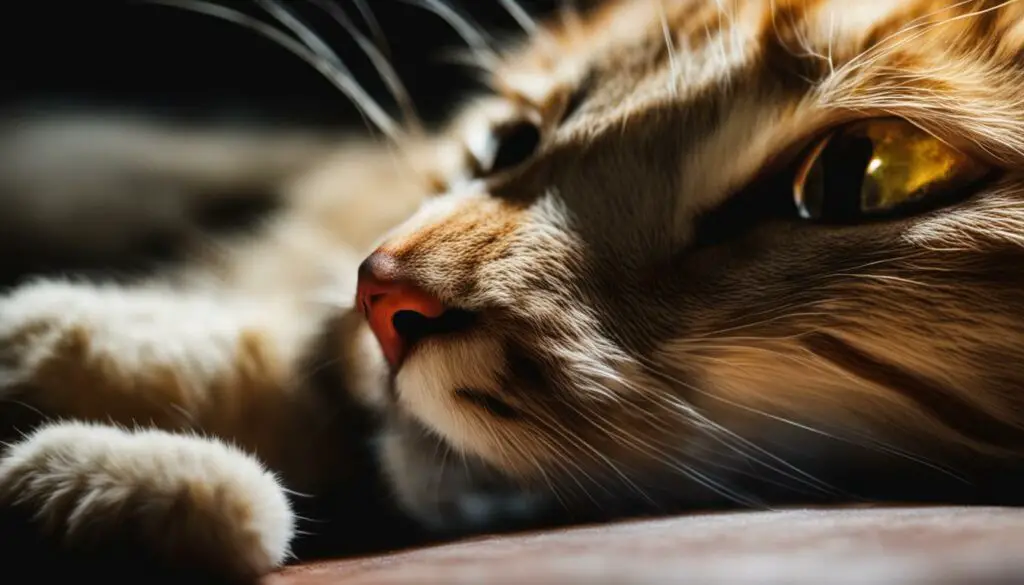
The Importance of Early Intervention
Early intervention is key when it comes to addressing urinary tract infections in senior cats. Left untreated, UTIs can progress to more severe conditions, such as kidney infections or kidney failure. By recognizing the signs of a UTI and seeking veterinary care promptly, you can help prevent these complications and ensure your senior cat receives the necessary treatment.
| Signs of UTIs in Senior Cats | Preventive Measures |
|---|---|
| Frequent urination | Provide fresh, clean water |
| Straining during urination | Feed a well-balanced diet for urinary health |
| Blood in the urine | Use specialized litters for senior cats |
| Increased thirst | Monitor litter box behavior |
“Addressing urinary tract infections in senior cats requires a multi-faceted approach that includes preventive measures, vigilant monitoring, and prompt veterinary intervention. By working closely with your veterinarian and taking proactive steps, you can help keep your senior cat healthy and comfortable.”
Remember, prevention is always better than a cure. By providing proper care, including regular check-ups with your veterinarian and a suitable environment, you can minimize the risk of urinary tract infections in your senior cat. Stay informed, stay proactive, and ensure your furry friend’s well-being in their golden years.
Senior Cat Nutrition and Weight Management
As our furry friends age, it’s important to pay extra attention to their nutrition and weight management. Senior cats have unique dietary needs that require special consideration to ensure they maintain a healthy weight and prevent muscle loss. A high-protein diet for senior cats is essential to support their muscle and bone health and help them stay active and agile well into their golden years.
One way to promote weight management in senior cats is by feeding them a high-protein diet. Protein is crucial for maintaining muscle mass and preventing muscle loss, which can occur as cats age. Look for cat food specifically formulated for senior cats and ensure that it contains a high percentage of animal-based protein. Brands like Dr. Elsey’s cleanprotein™ provide a clean and high-quality source of protein that is easily digestible for senior cats.
In addition to a high-protein diet, portion control is also important for managing your senior cat’s weight. As cats age, their metabolism slows down, so they require fewer calories to maintain a healthy weight. Consult with your veterinarian to determine the appropriate portion size for your cat based on their age, weight, and activity level. Regular monitoring of your cat’s weight and body condition will help you make adjustments to their diet if needed.
| Benefits of High-Protein Diet for Senior Cats | How to Implement a High-Protein Diet |
|---|---|
|
|
Keeping your senior cat at a healthy weight and providing them with a high-protein diet can help prevent muscle loss and support their overall well-being. Remember to consult with your veterinarian for personalized recommendations based on your cat’s specific needs. By prioritizing their nutrition and weight management, you can ensure that your senior cat enjoys a happy and healthy life.
Conclusion
In conclusion, owning a cat is a wonderful experience that brings joy and companionship into our lives. However, it is important to remember that cat ownership comes with responsibilities. Being a responsible pet owner means providing proper care, training, and attention to our feline friends.
Training your cat using positive reinforcement methods not only helps shape their behavior but also provides them with mental stimulation and a sense of fulfillment. By understanding their instincts and needs, we can create a harmonious environment for both ourselves and our cats.
Responsible pet ownership also includes providing the right nutrition, grooming, and healthcare. Regular visits to the veterinarian, proper nutrition suited to their life stage, and keeping up with grooming routines are all essential for their overall well-being.
By embracing the responsibilities of cat ownership and committing to meeting their needs, we can ensure that our feline companions lead happy, healthy, and fulfilling lives. So, if you’re considering bringing a cat into your home, remember to be a responsible pet owner and enjoy the purr-fect relationship that awaits.
FAQ
Should I get a cat?
Getting a cat is a personal decision, but it can be a wonderful experience. Cats make great companions and can bring joy to your life. However, owning a cat requires commitment, time, and responsibility. Consider factors such as your lifestyle, living situation, and ability to provide proper care before making a decision.
Why is training important for cats?
Training is important for cats because it provides mental stimulation and helps prevent boredom, destructive behavior, and obesity. Cats have a natural need to hunt, catch, and kill, and training satisfies this instinctual need. It also strengthens your bond with your cat and enhances their well-being.
What are the different training methods for cats?
The most effective training methods for cats include positive reinforcement, clicker training, and auditory markers. Positive reinforcement involves rewarding your cat with treats or affection when they exhibit desirable behavior. Clicker training uses a clicker to mark the desired behavior, and auditory markers use verbal cues to mark the behavior.
How can I train my cat successfully?
To train your cat successfully, it’s important to understand their body language and mood. Train your cat when they are hungry but not too full, and keep training sessions short and frequent. Use treats as positive reinforcement and reward your cat immediately when they perform a desired behavior. Teach one behavior at a time and be patient and consistent.
What do I need to train my cat?
To train your cat, you will need a clicker or auditory marker to mark desirable behavior. It’s also important to have irresistible treats that motivate your cat. Reserve the treats only for training to make them more enticing for your cat.
How do I train my cat to follow commands?
You can train your cat to sit by using a treat as a lure and rewarding them when they sit. To teach them to lie down, you can either capture the behavior or coax them to lie down with a treat. To train your cat to recognize its name, say their name and reward them when they turn to look at you.
How should I care for a kitten?
When caring for a kitten, it’s important to introduce them to a litter box at around four to five weeks old. Use a non-clumping litter during the oral or “litter tasting” stage, and switch to a kitten-specific litter when they are weaned. Provide a balanced diet for kittens and monitor their weight as they grow.
How can I introduce a new kitten to my home?
When introducing a new kitten to a multi-cat household, gradual introductions are recommended. Confine the new kitten to a separate room initially to allow them to acclimate to the scent of other cats. Gradually introduce them to the existing cats, starting with mealtime interactions, and progress to supervised play sessions.
How do I care for an adult cat?
Adult cats require proper grooming to prevent mats and tangles and reduce hairballs. They also benefit from having dedicated litter boxes in multi-cat households to prevent territorial issues. Monitoring litter box behavior and addressing any inappropriate elimination promptly is important for adult cat care.
How can I address litter box problems?
If your cat is experiencing litter box problems, it’s important to address them promptly. Use litter box training techniques and consider using products like Cat Attract, which is specifically designed to address inappropriate elimination. Consult a veterinarian if the problem persists.
How should I groom my adult cat?
Regular grooming is important for maintaining your cat’s coat health and reducing hairballs. Use a brush or comb to remove tangles and distribute natural oils. Create a calm and relaxing environment for grooming to make it a positive experience for your cat.
How can I manage a multi-cat household?
Managing a multi-cat household involves providing each cat with their own litter box to prevent territorial issues. It’s important to introduce new cats slowly and use proper introduction methods. Address any behavioral concerns and provide ample resources and attention to each cat to create a harmonious home environment.
How should I care for my senior cat?
Senior cats require specialized care to maintain their health and well-being. Regular monitoring, proper nutrition, and visits to the vet are essential. Addressing urinary tract infections and providing high-quality protein in their diet can help prevent kidney failure and muscle loss.
How can I address urinary tract infections in senior cats?
Senior cats are more susceptible to urinary tract infections, so it’s important to monitor their litter box behavior and consult with a veterinarian if there are any changes. Using a litter specifically designed for senior cats, like Dr. Elsey’s Senior Litter, can help prevent bacterial growth and keep your cat comfortable.
What should I feed my senior cat?
Senior cats have increased energy requirements and a decreased ability to absorb and metabolize protein. Providing them with high-quality animal-based protein, such as Dr. Elsey’s cleanprotein™, is crucial for their muscle and bone health. Regular monitoring of weight and visits to the vet are important for early detection of any health issues.

